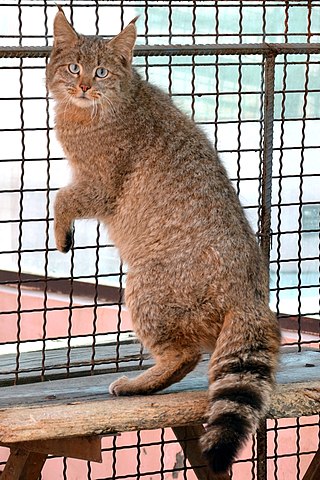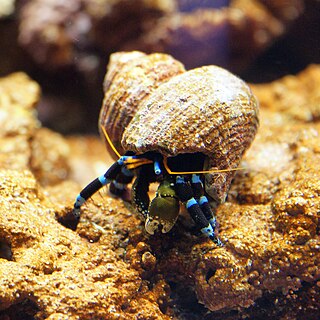
The Chinese mountain cat, also known as Chinese desert cat and Chinese steppe cat, is a small wild cat endemic to western China that has been listed as Vulnerable on the IUCN Red List since 2002, as the effective population size may be fewer than 10,000 mature breeding individuals.

Homarus gammarus, known as the European lobster or common lobster, is a species of clawed lobster from the eastern Atlantic Ocean, Mediterranean Sea and parts of the Black Sea. It is closely related to the American lobster, H. americanus. It may grow to a length of 60 cm (24 in) and a mass of 6 kilograms (13 lb), and bears a conspicuous pair of claws. In life the lobsters are blue, only becoming "lobster red" on cooking. Mating occurs in the summer, producing eggs which are carried by the females for up to a year before hatching into planktonic larvae. Homarus gammarus is a highly esteemed food, and is widely caught using lobster pots, mostly around the British Isles.

Ocypode is a genus of ghost crabs found in the sandy shores of tropical and subtropical regions throughout the world. They have a box-like body, thick and elongated eyestalks, and one claw is larger than the other in both males and females. They inhabit deep burrows in the intertidal zone. They are primarily nocturnal, and are generalist scavengers and predators of small animals. The genus contains 21 species.

Amphionides reynaudii is a species of caridean shrimp, whose identity and position in the crustacean system remained enigmatic for a long time. It is a small planktonic crustacean found throughout the world's tropical oceans, which until 2015 was considered the sole representative of the order Amphionidacea, due to unusual morphological features. Molecular data however confirm it as a member of the caridean family Pandalidae, and the confusion of morphology is because only larval phases have so far been studied.

Majidae is a family of crabs, comprising around 200 marine species inside 52 genera, with a carapace that is longer than it is broad, and which forms a point at the front. The legs can be very long in some species, leading to the name "spider crab". The exoskeleton is covered with bristles to which the crab attaches algae and other items to act as camouflage.

The smooth shore crab is a marine large-eyed crab of the family Grapsidae, found in New Zealand and the Juan Fernández Islands of Chile.

Acetes is a genus of small shrimp that resemble krill, which is native to the western and central Indo-Pacific, the Atlantic coast of the Americas, Pacific coast of South America and inland waters of South America. Although most are from marine or estuarine habitats, the South American A. paraguayensis is a fresh water species. Several of its species are important for the production of shrimp paste in Southeast Asia, including A. japonicus, which is the world's most heavily fished species of wild shrimp or prawn in terms of total tonnage.

Bellorchestia quoyana is the largest and most common species of sandhopper, endemic to New Zealand. Its length is up to 14 millimetres (0.55 in). They help to keep the beaches clean by breaking down any organic material, which is vital for plant succession. They are nocturnal and bury themselves up to 30 centimetres (12 in) during the day.

Acanthacaris is a genus of deep-water lobsters. It contains two species, A. caeca and A. tenuimana, and is the only genus in the subfamily Neophoberinae.

Calcinus elegans, also known as the blue line hermit crab, is a small, tropical hermit crab.

A giant isopod is any of the almost 20 species of large isopods, crustaceans distantly related to shrimp and crabs, which are decapods, in the genus Bathynomus. They are abundant in the cold, deep waters of the Atlantic, Pacific, and Indian Oceans. Bathynomus giganteus, the species upon which the generitype is based, is often considered the largest isopod in the world, though other comparably poorly known species of Bathynomus may reach a similar size. The giant isopods are noted for their resemblance to the much smaller common woodlouse, to which they are related.

Percnon gibbesi is a species of crab. It is one of at least two species commonly called "Sally Lightfoot", and is also referred to as the nimble spray crab or urchin crab. It has been described as "the most invasive decapod species to enter the Mediterranean".

Dardanus megistos, the white-spotted hermit crab or spotted hermit crab, is a species of hermit crab belonging to the family Diogenidae.

Johngarthia lagostoma is a species of terrestrial crab that lives on Ascension Island and three other islands in the South Atlantic. It grows to a carapace width of 110 mm (4.3 in) on Ascension Island, where it is the largest native land animal. It exists in two distinct colour morphs, one yellow and one purple, with few intermediates. The yellow morph dominates on Ascension Island, while the purple morph is more frequent on Rocas Atoll. The species differs from other Johngarthia species by the form of the third maxilliped.

Munida rugosa, commonly known as the rugose squat lobster or plated lobster, is a species of decapod crustacean found in the north east Atlantic Ocean and the Mediterranean Sea.

Neolithodes is a genus of king crabs, in the family Lithodidae. They are found in all major oceans, both in high and low latitudes. Although there are records from water as shallow as 124 m (407 ft) in cold regions, most records are much deeper, typically 700–2,000 m (2,300–6,600 ft), with the deepest confirmed at 5,238 m (17,185 ft). They are fairly large to large crabs that typically are reddish in color and spiny, although the size of these spines varies depending on species.

Isastrea is an extinct genus of corals that lived during the Jurassic and Cretaceous periods. Its fossils have been found in Europe, Africa, North America, Asia and South America.

Dardanus venosus, the starry-eyed crab or stareye crab, is a species of hermit crab in the family Diogenidae. It occurs in shallow water on the eastern coasts of America from Florida southward to Brazil. It is sometimes kept in reef aquaria.

The pink hermit crab is a species of hermit crab in the family Diogenidae.

Heterocyathus is a genus of coral of the family Caryophylliidae.




















